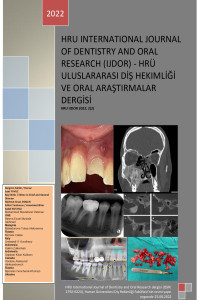Teacher’s Preferences to Receive Oral Health Information Using Internet
Teacher’s Preferences to Receive Oral Health Information Using Internet
Preference, social media, teacher, oral health information,
___
- 1. Yonker LM, Zan S, Scirica CV, Jethwani K, Kinane TB. “Friending” teens: Systematic review of social media in adolescent and young adult health care. Journal of Medical Internet Research. 2015;17(1):4.
- 2. Abreu LG. Orthodontics in Children and Impact of Malocclusion on Adolescents’ Quality of Life. Pediatric Clinics of North America. 2018;65(5);995-1006.
- 3. Harris CE, Chestnutt IG. The use of the Internet to access oral healthrelated information by patients attending dental hygiene clinics. International Journal of Dental Hygiene. 2005;3(2):70-3.
- 4. Moorhead SA, Hazlett DE, Harrison L, Carroll JK, Irwin A, Hoving C. A new dimension of health care: Systematic review of the uses, benefits, and limitations of social media for health communication. Journal of Medical Internet Research. 2013;15(4):e85.
- 5. El Tantawi M, Al-Ansari A, AlSubaie A, Fathy A, Aly NM, Mohamed AS. Reach of messages in a dental twitter network: Cohort study examining user popularity, communication pattern, and network structure. Journal of Medical Internet Research. 2018;20(9):e10781.
- 6. Vettore MV, Ahmad SFH, Machuca C, Fontanini H. Socio-economic status, social support, social network, dental status, and oral health reported outcomes in adolescents. European Journal of Oral Sciences. 2019;127(2):139-146
- 7. McCuaig L, Rossi T, Enright E, Shelley K. Schools, student health and family welfare: Exploring teachers’ work as boundary spanners. British Educational Research Journal. 2019;45(5):1001-20.
- 8. Bonell C, Blakemore SJ, Fletcher A, Patton G. Role theory of schools and adolescent health. Lancet Child & Adolescent Health. 2019;3(10):742-748
- 9. Bonell C, Parry W, Wells H, Jamal F, Fletcher A, Harden A. et al. The effects of the school environment on student health: A systematic review of multi-level studies. Health Place. 2013;21: 180-191.
- 10. Bradley BJ, Greene AC. Do health and education agencies in the United States share responsibility for academic achievement and health? A review of 25 years of evidence about the relationship of adolescents’ academic achievement and health behaviors. Journal of Adolescent Health. 2013;52(2):523-32.
- 11. Bosak K, Park SH. Characteristics of adults’ use of Facebook and the potential impact on health behavior: Secondary data analysis. Interactive Journal of Medical Research. 2018;7(1): e11.
- 12. Grajales FJ, Sheps S, Ho K, Novak-Lauscher H, Eysenbach G. Social media: A review and tutorial of applications in medicine and health care. Journal of Medical Internet Research. 2014;16(2): e13.
- 13. El Tantawi M, Bakhurji E, Al-Ansari A, AlSubaie A, AlSubaie HA, AlAli A. Indicators of adolescents’ preference to receive oral health information using social media. Acta Odontologica Scandinavica. 2019;77(33):213-8.
- 14. Pollard CM, Pulker CE, Meng X, Kerr DA, Scott JA. Who Uses the Internet as a Source of Nutrition and Dietary Information? An Australian Population Perspective. Journal of Medical Internet Research. 2015;17(8):209.
- 15. Al-Ubaydli, M. Using search engines to find online medical information. PLOS Medicine. 2005;2(9): e228.
- 16. Wang L, Wang J, Wang M, Li Y, Liang Y, Xu D. Using Internet search engines to obtain medical information: a comparative study. Journal of Medical Internet Research. 2002;14(3): 74.
- 17. Hansen C, Interrante JD, Ailes EC, Frey MT, Broussard CS, Godoshian VJ et al. Assessment of YouTube videos as a source of information on medication use in pregnancy. Pharmacoepidemiology and Drug Safety. 2016;25(1):35-44.
- 18. Drozd B, Couvillon E, Suarez A. Medical YouTube Videos and Methods of Evaluation: Literatur Review. JMIR Medical Education. 2018;4(1): 3.
- 19. Goulart MA, Condessa AM, Hilgert JB, Hugo FN, Celeste RK. Concerns about dental aesthetics are associated with oral health related quality of life in Southern Brazilian adults. Cien Saude Colet. 2018;23(11), 3957-64.
- 20. Thomson WM, Broder HL. Oral-Health-Related Quality of Life in Children and Adolescents. Pediatric Clinics of North America. 2018;65(5):1073-84.
- 21. Ahmed HO, Zmnako SSF, Amin ZM, Ezzat RF, Kakarash A, Omer SH. et al. Impact of the halitosis on QoL in overweight and obese patients: Based on six years of experience in two centers in sulaimani governorate, Kurdistan Region/Iraq, and case series study. Annals of Medicine and Surgery. 2019;43:33-37.
- 22. Bennadi D, Reddy CVK. Oral health related quality of life. Journal of International Society of Preventive and Community Dentistry. 2013;3(1): 1-6.
- 23. Tse MM, Choi KC, Leung RS. E-health for older people: the use of technology in health promotion. CyberPsychology & Behavior. 2008;11(4): 475-9.
- 24. Song H, Omori K, Kim J, Tenzek KE, Hawkins JM, Lin WY et al. Trusting Social Media as a Source of Health Information: Online Surveys Comparing the United States, Korea, and Hong Kong. Journal of Medical Internet Research. 2016;18(3):25.
- 25. Korda H, Itani Z. Harnessing Social Media for Health Promotion and Behavior Change. Health Promotion Practice. 2013;14(1):15-3.
- Başlangıç: 2021
- Yayıncı: Harran Üniversitesi
Oculo-Dento-Digital Dysplasia (Oddd), Report of a Case
Pamela ARMİ, Roberta D’AVENİA, Cristina VİLLANACCİ, Francisco Cammarata SCALİSİ, Michele CALLEA
Çocuklarda Endodontik Enfeksiyonlara Bağlı Antibiyotik Kullanımı
Gizem KARAGÖZ DOĞAN, İsmet Rezani TOPTANCI
An In Vitro Microleakage Evaluation of a New Cold Flowable Gutta-Percha Based Sealer
Betül YAZMACI, Muhammed DEMİR, Mehmet Sinan DOĞAN
Muhammed DEMİR, Fatih TULUMBACI
Talon Tuberculosis and Conservative Approaches: Two Case Reports
Teacher’s Preferences to Receive Oral Health Information Using Internet
Peter ANDREAS, Mutiara AMANDA, Iwany Amalliah BADRUDDİN, Febriana SETİAWATİ, Diah MAHARANİ
Mehmet Emin DOĞAN, Eda Didem YALÇIN
Endokron Restorasyonlar ve Endokron Restorasyonlarda Kullanilan Materyaller
Esengül SEZGİN, Yakup KANTACI, Burcu ÜSTÜN
Evaluation of Delayed Splint Removal and Root Resorption due to Pandemic: Case Report
